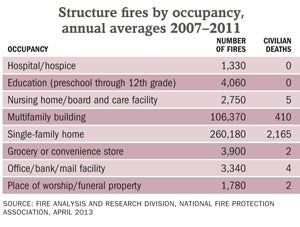Codes and enforcement credited with decline in fires
 |
|---|
| The data show that hospitals are one of the safest facilities in the United States in terms of fires. |
While still a critical issue that requires ongoing vigilance, the number of fires each year in hospitals and hospices continues to drop, according to a recent report by the National Fire Protection Association (NFPA).
The NFPA reports that U.S. fire departments responded to an estimated average of 6,240 structure fires in all health care facilities per year in 2006–2010. With one exception, the number of fires has dropped continuously each year from 6,830 in 2003 to 5,540 in 2010.
Fires in all health care facilities during the five-year period of 2006–2010 caused an annual average of six civilian deaths, 171 civilian injuries and $52 million in property damage. The report includes hospitals or hospices, mental health facilities, doctors' offices or clinics, and nursing homes, which is where nearly all the fire fatalities occurred.
The average number of fires in hospitals and hospices dropped 10 percent from 2006–2010 compared with 2003–2006, NFPA data show. From 2006–2010 there were an average of 1,430 fires per year compared with an average of 1,600 from 2003–2006 in hospitals and hospices.
Moreover, the number of fires per year in hospitals and hospices has dropped dramatically from 1980 when there were 8,330 incidents compared with 2010 when there were 1,200, the NFPA reports.
Robert Solomon, division manager, building fire protection and life safety, NFPA, cites several reasons for the ongoing reduction of fires in health care facilities.
"It's because of the adoption of newer, more modern code requirements, better enforcement and a broader awareness by hospital administrators and management of the threats posed to all of the occupants by even the smallest of fires," he says. "They all combine to reduce the chance of a fire in these environments."
Solomon also says the ongoing oversight and inspection by entities such as the Centers for Medicare & Medicaid Services and accreditation organizations such as the Joint Commission and DNV (Det Norske Veritas) "ensure that the fire problem stays in front of the hospital personnel 24 hours a day."
Another contributing factor to the decline are the severe restrictions or elimination of smoking in these occupancies beginning in the early '90s, NFPA says.
Fires caused by cooking equipment are an ongoing problem for all health care facilities, including hospitals and hospices, according to the NFPA report. Nearly half (49 percent) of fires in all health care facilities started in the kitchen or cooking area, as did 42 percent of fires in hospitals and hospices.
Cooking equipment was the cause of the fire in 61 percent of cases in all health care facilities and 58 percent of the time in hospitals and hospices. There were no fatalities from the fires and the level of damage was relatively low compared with all health care facility fires from 2006 to 2010.
"Cooking fires are possible any place that cooking occurs," says Marty Ahrens, manager of fire analysis services, fire analysis research division, NFPA. "Cooking fires tend to be minor. Although three out of five health care facility fires were caused by cooking, these fires caused only 4 percent of the direct property damage."
The next most common locations for health care facility fires was the laundry room or area and the patient room or bedroom, both areas representing 6 percent of all fires.
Not surprisingly, the average property loss per 1,000 fires in all health care facilities was 61 percent lower when wet pipe sprinklers were present. The average loss per fire without automatic extinguishing equipment was $13,000 compared with $5,000 when wet pipe sprinklers were present.
When present in a fire large enough for a sprinkler to operate, the systems operated 88 percent of the time and were effective in controlling the fire in 98 percent of the fires in which they operated, NFPA says.
In commenting on the NFPA report, Chad E. Beebe, AIA, CBO, SASHE, director, codes and standards, American Society for Healthcare Engineering, says, "There are too few fire incidents in hospitals to draw any statistically significant conclusions on hospitals. There is not enough information to base conclusions on the report about hospital fires, but ASHE supports the sprinklering of hospitals."
He also notes that the number of fires reported at hospitals may be inaccurate because fire department personnel may report a fire as occurring at a hospital even if it occurred at a different building or place on the same campus.




